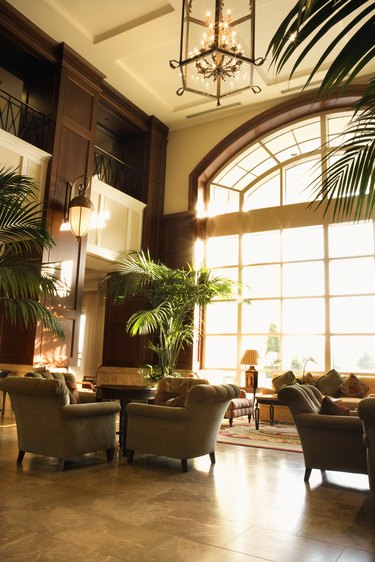
Also called the sentry or hotel palm, kentia palm (Howea forsteriana) hails from the low elevations on Lord Howe Island off the coast of eastern Australia. There, this single-trunked palm matures 50 to 60 feet tall, but when grown in tropical gardens elsewhere, it tends to get only 20 to 30 feet in final height. Tolerant of low light and arid air common in homes and offices, kentia palm has been used extensively as an interior plant since the late 19th century. Improper growing conditions can lead to leaf yellowing.
Light Exposure
Video of the Day
In the United States, kentia palms may be grown outdoors only in frost-free regions, such as Hawaii, coastal Southern California, Puerto Rico and southernmost Florida. Most of these palms are raised in shaded greenhouses for use as indoor plants. This acclimates the short, young, arching-leaved palms to the lower light levels expected inside buildings. However, in its natural habit, kentia palms grow in full sun. If a shade-grown kentia palm is exposed to excessive sunlight too quickly, the fronds will scald and yellow as a result. Kentia palm will produce new leaves that are fully green one to two years after being exposed to full sun growing conditions.
Video of the Day
Soil Moisture Insight
Both excessively dry and wet soils can lead to yellowing of kentia palm leaves. Dry soil limits growth and ability to sustain plant tissues, while soggy/flooded conditions suffocate roots and cause rot so the fronds do not receive ample moisture and nutrients. Grow kentia palm in any freely draining soil in the ground or in containers. It performs best with moderate but regular water. In sunnier locales and in sandy soils, more frequent watering is needed. Indoors where temperatures are cooler and light at a lower intensity, an evenly moist to slightly dry soil suffices.
Growth Considerations
Overall, kentia palms are slow growing plants and that is one reason their use as a houseplant is advantageous -- it will not quickly outgrow its container or the room. Expect oldest, lower fronds on kentia palms to yellow because of old age. More alarming is when younger or newly emerging leaves are yellow, which suggests a severe nutrient deficiency. Seedling kentia palms should not be grown in full sunlight, which will cause stress and leaf yellowing. After 5 years of age, the seedlings are best able to grow in lots of sun.
Nutrition
For best growth, plant kentia palms in an organic-rich soil with compost, peat or other decomposing plant matter mixed with the soil. Lack of nitrogen leads to white new growth, and yellow new growth suggests a lack of magnesium, manganese, iron or potassium. Outdoors, use a balanced, slow-release granular palm fertilizer with micronutrients to maintain adequate nutrition in the soil for the palm. Indoors, you can use balanced slow-release granules on the soil surface in addition to applying dilute liquid fertilizers in tandem with watering. It's best to use liquid fertilizers only in the warmer, longer days of spring to fall. Don't fertilize in winter.